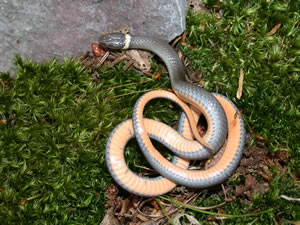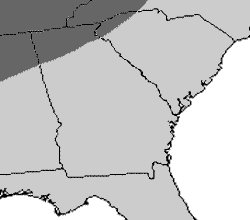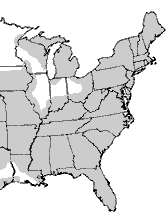Ringneck Snake (Diadophis punctatus)

Image is of a northern ringneck.


Photos by J. D. Wilson unless otherwise noted
| Description: Ringneck snakes are small — 10 – 15 in (25 – 38 cm) — slender snakes that are generally grayish with a yellow or orange band around the back of the neck and a yellow or orange underside. Two subspecies are found in our region. The northern ringneck snake (Diadophis punctatus edwardsi) inhabits the mountains and generally has a complete neck ring and unpatterned underside. The southern ringneck (D. p. punctatus) is found in the Coastal Plain and often has a broken neck ring and underside that is marked with a single row or black spots. The northern ringneck is also generally larger than the southern. Although usually grayish in coloration, both subspecies may range from nearly black to tan and both have smooth scales and round pupils. Females are larger and have proportionally shorter tails than males.
Range and Habitat: The ringneck snake has one of the largest geographic ranges of any species of snake in North America and is represented by several subspecies. Ringnecks are found throughout the eastern two thirds of the United States from southern Canada to Florida, across the desert southwest and along most of the Pacific coast. Ringnecks are found throughout Georgia and South Carolina with the northern subspecies (D. p. edwardsi) inhabiting the mountains and the southern subspecies (D. p. punctatus) being found in the Coastal Plain. Ringnecks from the Piedmont are intergrades between the two races. Ringneck snakes can be found in virtually any habitat but seem to prefer wooded areas. In the Piedmont and Coastal Plain ringnecks are particularly common in moist areas including river floodplains, moist hardwood forests, and wetland edges. In mountainous regions ringnecks are often found in more open habitats where they frequently take refuge under rocks. Habits: Like other small woodland snakes in the Southeast, ringneck snakes spend most of their time underground or hidden under logs, rocks, leaf litter, or debris. However, ringnecks can occasionally be found crawling in the open or crossing roads, often at night. Ringnecks are one of the more common species in many habitats in the Southeast and in other parts of their range can reach extraordinary densities. As part of his famous long-term mark-recapture snake studies in Kansas, Henry Fitch estimated that ringneck snakes exist at densities greater than 700 – 1800 per hectare (2.47 acres). Because of their abundance, ringnecks probably play an important ecological role as intermediate predators in community food webs, functioning as both predator and prey. Although they are completely harmless to humans, ringnecks have weak venom in their saliva which they use to subdue their prey, which include a variety of invertebrates, amphibians, lizards, and other small snakes. In many regions, salamanders and earthworms are particularly important prey. Ringneck snakes probably mate in the fall in our region, and females lay 2-7 eggs in the early summer. The young resemble adults. Conservation Status: Ringneck snakes are common in our region and are not protected throughout most of it. This species is protected throughout the state of Georgia. Pertinent References: Willson, J. D., and M. E. Dorcas. 2004. Aspects of the ecology of small fossorial snakes in the western Piedmont of North Carolina. Southeastern Naturalist 3:1-12. Fitch, H. S. 1975. A demographic study of the ringneck snake (Diadophis punctatus) in Kansas. University of Kansas Museum of Natural History Miscellaneous Publications 62:1-53. Account author: Stacey Vigil, University of Georgia – edited by J.D. Willson |
